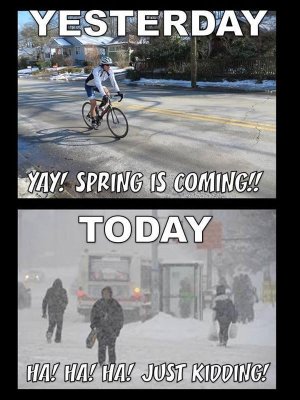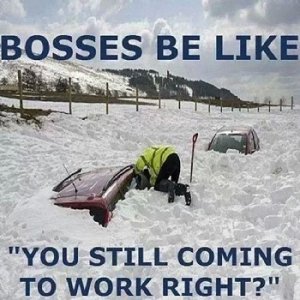You are using an out of date browser. It may not display this or other websites correctly.
You should upgrade or use an alternative browser.
You should upgrade or use an alternative browser.
Weather related aphorisms, sayings, adages.
- Thread starter OregonGuy
- Start date
ChiroDoc
Senior Member
- Location
- The Dixie Riviera
Heard said inmost places where I've lived : "If you don't like the weather, just wait 15 minutes."
I guess that's a common sentiment..
I guess that's a common sentiment..
jujube
SF VIP
"Might as well....can't dance and too wet to plow" was something I heard a lot in my younger days.
My favorite: "Mother Nature sure has her knickers in a twist today!"
And then there's always: "Three Dog Night", meaning it's colder 'n hell out there and you'd better have a few dogs on the bed tonight to keep you warm.
My favorite: "Mother Nature sure has her knickers in a twist today!"
And then there's always: "Three Dog Night", meaning it's colder 'n hell out there and you'd better have a few dogs on the bed tonight to keep you warm.
Paco Dennis
SF VIP
- Location
- Mid-Missouri
"Don’t knock the weather; nine-tenths of the people couldn’t start a conversation if it didn’t change once in a while." 
MaidMarian
Member
- Location
- Baltimore, Maryland USA
Hot enough to fry an egg on the sidewalk.
Oldeagle66
Senior Member
That's funny because I thought I made it upOld saying "It is colder than a witches tit"View attachment 398132View attachment 398133
horseless carriage
Well-known Member
We seem to use the weather in euphemisms like: Storm in a teacup, Face like thunder, The calm before the storm, It's a breeze, Cloud nine, Under the weather, Head in the clouds, Every cloud has a silver lining, Snowed under. There must many more.
Tommy
Senior Member
- Location
- New Hampshire
I once had a friend who would refer to a heavy rain event as a "frog strangler" or a "gully washer". 
jujube
SF VIP
My dad would call them "dust settlers", "soil soakers", or "gully washers". I hadn't heard "frog strangler" but I like it.
Of course the old folks would say, "Ayuh, big storm a'comin'. Mah bad knee is aching up."
Of course the old folks would say, "Ayuh, big storm a'comin'. Mah bad knee is aching up."
jujube
SF VIP
I always wished I could have had a job where I was wrong more than I was right, but I still got paid great quantities of money to do....
RadishRose
SF VIP
- Location
- Connecticut, USA
The answer was "not if it's in cans", but we didn't day that part often.When we were teenagers we used to fill lulls in the conversation with, "Do you think the rain will hurt the rhubarb?" Don't know where we got that, but we thought it was funny.
RadishRose
SF VIP
- Location
- Connecticut, USA
"The sky looks moody".
OneEyedDiva
SF VIP
- Location
- New Jersey
The Weather Girls' song: It's Raining Men.
Oregon Guy and @Oldeagle66... I was just thinking the other day that our studio room is "colder than a witch's tit" ! My son didn't cover the window that has an air conditioner in it before the below freezing weather came.
Oregon Guy and @Oldeagle66... I was just thinking the other day that our studio room is "colder than a witch's tit" ! My son didn't cover the window that has an air conditioner in it before the below freezing weather came.
Last edited:
AnnieA
Well-known Member
- Location
- Down South
Colder than a well diggers butt in Idaho. 
jujube
SF VIP
I know....I just stepped in a poodle.It's raining cats and dogs.
jimintoronto
Well-known Member
Actually some of the more sensible companies, that have vehicle fleets driven by company drivers, send the drivers to "Skid School " where they learn how to avoid and or deal with skids on snow covered or icy road winter roads. When I worked for Metropolitan Toronto Ambulance, all of us had to go through the skid school every two years, to refresh our driving skills.
The training school was on a decommissioned air force base, and we used the runways to train on. The runways would be watered and then sprayed with liquid soap, to simulate ice or snow conditions. We were driving our normal Dodge van Ambulance vehicles with a full load of equipment inside. The instructors would lay out a pylon course that we had to drive through at a specified speed, and each time though the curved course we had to drive at a higher speed to simulate a high speed run in city traffic. We also had to reverse through the pylons without touching any of them, but at a lower speed, of course.
One of the harder tasks was the "pick a lane " situation, where you would drive at a steady 40 mph speed, then the on board instructor would call out "go left" and you would have to make a fast lane change, to the left, which would cause the vehicle to skid hard. Now you had to not only control the skid, but stay within the lane markings, too .
Braking during a skid is not the right thing to do, as locked up front tires cannot effectively steer the vehicle. Steer into the direction of the skid, and keep off the brakes until you have control of the direction of the vehicle, and reduce vehicle speed by getting off the gas pedal. If the vehicle has an automatic transmission, put it into neutral, to cut power to the drive wheels. LOOK where you want the vehicle to go, and steer in that direction.
Like any physical skill, driving requires practice and education and repeating the process. JIM.
Happyflowerlady
Vagabond Flowerchild
- Location
- Northern Alabama
January was a really hard year, but we made it though it !








